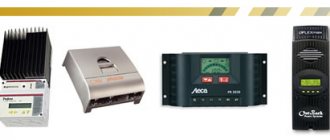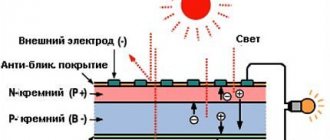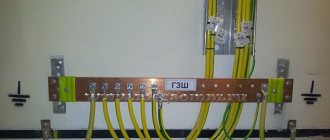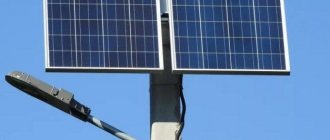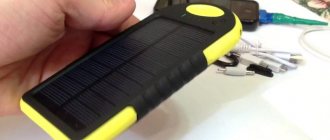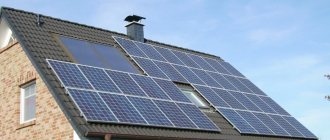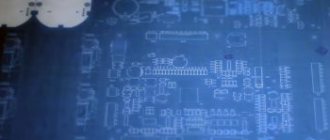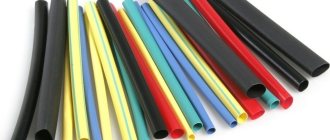Until recently, there was only one answer to the question “what are solar panels made of” - silicon cells in a rigid frame with thick protective glass. Today the situation has changed dramatically, although silicon-based panels still occupy the majority of the global market. When making photovoltaics at home, from scrap materials, such cells are also used more often than others. However, promising developments in recent years are created using completely different technologies and are significantly different from older models in design.
A brief history of modification: three generations of solar cells
Experts divide all photovoltaic devices capable of absorbing light photons and converting them into electric current into three generations.
- What are the first generation solar panels made of?
Structurally, such modules consist of the following elements:
- base metal sheet – base contact;
- the lower additive layer of a silicon semiconductor with a predominance of n-type electrons - due to the addition of phosphorus;
- an upper crystalline layer saturated with p-type electrons - usually by doping with boron;
- anti-reflective coating - to maximize radiation absorption;
- thin metallized mesh-type contact with a wire to close the network;
- thick protective glass - usually heavy-duty tempered;
- framing frame.
The thickness of monocrystalline Mono-Si or polycrystalline Poli-Si silicon wafers in cells is about 200-300 microns. The service life is estimated at 20-25 years, with an average performance loss of 0.5% annually. The efficiency under ideal lighting conditions reaches 22-24% and decreases sharply at high temperatures or a partial drop in illumination.
A little history
The first attempts to use solar energy to generate electricity were made back in the mid-twentieth century. At that time, the leading countries of the world attempted to build efficient thermal power plants. The concept of a thermal power plant involves using concentrated sunlight to heat water into steam, which in turn rotates the turbines of an electrical generator.
Since such power plants used the concept of energy transformation, their efficiency was minimal. Modern devices directly convert the sun's rays into current thanks to the concept of the photoelectric effect.
The modern operating principle of a solar cell was discovered back in 1839 by a physicist named Alexandre Becquerel. In 1873, the first semiconductor was invented, which made it possible to put the principle of operation of a solar cell into practice.
What are second generation solar panels made of?
The next generation of batteries uses the same physical principle of p/n junction, but is created on the basis of combinations of rare earth elements (less commonly, amorphous silicon). The auxiliary structural elements of the panels are in most cases the same - a metal base, anti-reflective film and protective glass. However, frameless designs are increasingly appearing, as well as thin-film options that can be rolled up and bent at any angle.
The most common semiconductors for the cells of such batteries are:
- amorphous silicon a-Si;
- cadmium telluride (CdTe);
- indium/gallium/copper selenide (CIGS).
Sometimes, when asked to give examples of what thin-film solar panels are made of, specialized experts also cite other, more exotic options. However, their total share does not exceed 0.1% and is used mainly in laboratory research.
The name “thin film” comes from the significantly smaller thickness of the working layers – from 1 to 3 microns, which is almost 100 times less than that of the “classic” silicon. The efficiency of thin films under ideal conditions is 16-20%. However, with diffuse light and/or high angles of incidence, CdTe/CIGS panels may be more effective.
3. What does a third generation solar battery consist of?
The operating principle of the 3rd generation panels is still photovoltaic, but the design is fundamentally different. Semiconductor materials, with the exception of quantum dots, are not used at all, giving way to organics and polymers.
Such batteries often have no frame or protective glass and are 3D printed or etched, similar to computer circuit boards.
Their main advantage is the fantastic low cost of production, the widest possible geometry and transparency. The third generation is the panels of the near future, which will be built into houses, windows, clothes and even the smallest household items everywhere.
The main disadvantage today is the low efficiency, ranging from 0.1 to 7%.
Semiconductor materials - what solar panels are made of today
The main semiconductor materials used to produce 99% of photovoltaic cells on the global market today are:
- Monocrystalline silicon
- Grown in the form of large crystals using the method of Professor Czochralski. Next, the silicon cylindrical “ingots” are cut into very thin disks 0.2-0.4 mm thick and subjected to specialized chemical treatment. Almost finished cells are turned, ground, covered with a protective coating and metallized. If you want to make a solar battery with your own hands, such photovoltaic elements are bought in a store, and the remaining parts of the monoblock are made independently from scrap materials. - Polycrystalline silicon
- Produced in metallurgical crucibles using a cheaper method of directional crystallization (block-cast). After the silicon raw material is melted, it is slowly cooled, which leads to the formation of “needle-shaped” multidirectional crystals. In operation, such a surface is slightly worse than a single crystal in ideal lighting, but is more effective in other cases. For this reason, when installing a set of batteries on roofs, Mono-Si is often installed on the southern slopes, and Poli-Si on the southwestern and southeastern slopes. - Amorphous silicon
- what are solar cells of this type made from? The basis of batteries of this type is hydrogenated silicon with a high radiation absorption coefficient. Modern models combine several layers enriched with germanium and carbon. This eliminates the main drawback of a-Si panels – the rapid degradation of cells.
This modification is no longer called amorphous, but micromorphic silicon and shows an efficiency of up to 12%. The low efficiency is compensated by the low cost of production, since such element cells require 200 times less semiconductor than Mono-Si or Poli-Si.
Solar heating of houses
The principle of operation of a solar battery for heating a house fundamentally distinguishes them from all the devices described above. This is a completely different device. Description follows below.
The main part of a heating system powered by solar energy is the collector, which receives its light and converts it into kinetic energy. The area of this element can vary from 30 to 70 square meters.
Special equipment is used to mount the collector. The plates are connected to each other by metal contacts.
The next component of the system is the storage boiler. It transforms kinetic energy into thermal energy. It is involved in heating water, the displacement of which can reach 300 liters. Sometimes such systems are supported by additional dry fuel boilers.
The solar heating system is completed by wall and floor elements, in which heated liquid circulates through thin copper pipes distributed over their entire area. Due to the low start-up temperature of the panels and the uniformity of heat transfer, the room warms up quite quickly.
What are CdTe thin film solar cells made of?
Cadmium telluride is considered the best unijunction semiconductor material based on a combination of three indicators - absorption capacity, reliability, and cost. CdTe is significantly more productive than silicon and much cheaper than more efficient films based on expensive germanium and indium.
The film substrate may not be metal, but glass, and the cells themselves may be semi-rigid or flexible. CdTe is characterized by stability, durability, low sensitivity to changes in lighting and rapidly growing efficiency of new generations of modules.
Types of solar panels
In general, a solar battery is a structure containing dark parts with metal strips that conduct electric current. The parts are covered with glass. The existing variety of solar cells is shown in the figure.
Classification Varieties
— By power Up to 10 W — From 200 W
By type of photocells
— Photochemical — Organic type — Base — silicon semiconductors — Base — gallium arsenide
By flexibility
— Flexible (can be folded up conveniently and are popular among tourists).
Photo of a solar battery that can be rolled up
— Portable
Portable solar battery
What are GaAs and InP solar cells made of?
The basic rare earth elements of this group of panels are gallium arsenide GaAs and indium phosphide InP. A distinctive feature of both cell options is the almost complete preservation of efficiency at temperatures of several hundred degrees Celsius.
Their use on earth is not financially feasible, but almost all solar panels of space satellites, probes, ISS and telescopes are made on their basis. The theoretical efficiency of this group, provided that additional concentrators are used in the design, can reach 85%. Practical records today fluctuate in the 35-45% zone.
How the elements in the battery are connected
Since the output voltage of an individual element is small (usually 0.6 V), they are connected into batteries, including in series. To increase the output current, such batteries, we will call them modules, are connected in parallel. In the figure below we see a battery consisting of two modules connected in parallel. Diodes serve to ensure that the current from a module with a high EMF does not flow into the neighboring one, and the voltage from the battery does not “drain” back into the panel at night.
Diagram of a solar battery consisting of two modules of 30 elements each
Solar batteries are often referred to as power plants consisting of a panel (panels), a special controller, a battery and often a DC-to-AC 220 V converter. This is not entirely true, since a battery, strictly speaking, is precisely a panel or a group of panels connected in one way or another .
What are organic solar cells made of?
Despite the low efficiency (the laboratory record today is 10.8%, commercial prototypes are up to 7%), organic-based panels of the 3rd generation are being actively researched today. Polymers of organic origin are characterized by the following important features:
- simplicity and low cost of creation;
- no problems with disposal;
- unlimited scope of application;
- Possibility of production in transparent form.
Such panels are practically weightless, and when using “tandem solar batteries” technology (tandem connection), they can be built into windows and the transparency can be adjusted.
Advantages and disadvantages
Solar energy is an alternative, renewable source; its use is considered a progressive way of energy consumption. Its advantages are described as follows:
- Your monthly energy bills go down (and ideally disappear). The degree of savings depends on the size of the installed system and the volume of consumption.
Technology that doesn't require space Source electrotile.com
- If the system is installed on your own site, you do not need to obtain permission to install the equipment.
- There is an opportunity to make money if you produce enough electricity to sell it to the government.
- Maintenance costs remain very low.
- Light weight, trouble-free operation, no noise.
- Solar energy is a dynamic industry, and the efficiency of solar panels is constantly improving. Modern models can work even in completely cloudy conditions (production is reduced).
People who are skeptical about installing solar panels rely on the following facts:
- The panels require investment, they need space for installation, and the efficiency is quite low even for the best models.
- The panels can only serve as a source of energy during the day. To use the gifts of green energy around the clock, you need a battery - a buffer storage device, as well as an inverter (a device for converting direct current into alternating current). “Free energy from nature” can hardly be called cheap.
See also: Catalog of companies that specialize in electrical work of any complexity
- Green technology harms the environment no worse than traditional combustion of any fuel. It is worth remembering the features of production and, especially, disposal of panels and batteries. Its environmental friendliness is a big question.
- Such an energy source can hardly be called independent. You do not have points of intersection with government networks, but you cannot do without companies involved in maintenance, repair of systems, and sale of components.
- It is not always possible to achieve a payback for the system; more often than not, the technology turns out to be unprofitable. The point is inattentive selection of panels, low productivity, and unsuitable climatic conditions.
Features of solar cells with quantum dots
The latest promising type of battery for the near future is based on the properties of physical quantum dots - microscopic inclusions of semiconductors in a particular material. Geometrically, such “dots” are several nanometers in size and are distributed in the material so as to cover the absorption of radiation from the entire solar spectrum - IR, visible light and UV.
A huge advantage of such panels is the ability to work even at night, generating about 40% of the maximum daytime power.
Physical and technical characteristics, certification and marking
Regardless of what solar panels are made of, each of them has the following important characteristics:
- mechanical
- geometric parameters, total weight, type of frame, protective glass, number of cells, type and width of connectors; - electrical or current-voltage
- power, open circuit voltage, current at maximum load, efficiency of the panel as a whole and individual cells in particular; - temperature
- change in efficiency when the temperature increases by a certain unit of value (usually 1 degree); - qualitative
– service life, cell degradation rate, presence in Bloomberg rating lists; - functional
– necessity and ease of maintenance, ease of installation/disassembly.
Industrial solar panels, no matter what materials they are made from, must be certified. The minimum requirements are ISO, CE, TUV (international) and/or Customs Union quality certificates (when sold within its borders).
International labeling rules are also mandatory. For example, the abbreviation CHN-350M-72
contains the following information:
- CHN
– identifier of the manufacturer (in this case, Chinese ChinaLand); - 350
– panel power in watts; - M
– designation of monocrystalline silicon; - 72
– number of photovoltaic cells in the module.
What can you use to make solar panels with your own hands at home?
To do this you need the following:
- Pre-drawn diagram and calculations.
- A certain number of factory-made solar cells - the cheapest way to buy them is online, for example, on the Aliexpress website or in other online stores. Make sure that all elements have the same electrical characteristics.
- A homemade frame made of timber and plywood - the rules for its assembly can be seen in numerous videos on the Internet.
- Plexiglass or plexiglass for surface protective coating.
- Paint and heat-resistant glue for treating wooden surfaces.
- Contact strips and wires for connecting cells. Diagrams of various connection methods can also be studied on the Internet.
- Soldering iron and solder. Soldering work should be carried out very carefully so as not to damage the future product.
- Silicone glue and self-tapping screws for securing the prefabricated battery to the frame.
A small battery will require about a $30-50 investment, while a factory version of similar power will cost only 10-20% more. Of course, such a home-made design will not last 25 years, will not boast significant efficiency and will not have the power of a full-fledged solar power plant for a private home. However, its cost will be as minimal as possible.
Scope of solar energy
There are three areas for using solar energy:
- Energy saving. Solar panels allow you to abandon centralized power supply or reduce its consumption, as well as sell excess electricity to the power supply company.
- Providing electricity to facilities to which connecting power lines is impossible or economically unprofitable. This could be a summer cottage or a hunting lodge located far from power lines. Such devices are also used to power lamps in remote areas of the garden or bus stops.
- Power supply for mobile and portable devices. When hiking, fishing trips and other similar activities, there is a need to charge phones, cameras and other gadgets. Solar cells are also used for this.
Solar panels are convenient to use where electricity cannot be supplied
Photocells and their replacement
Homemade solar battery production will inevitably be inferior to products from industrial companies. Even if you use the best materials. The fact is that manufacturers have a scrupulous selection of photocells, discarding all of them, with the slightest underestimation of parameters.
And special glass is used to protect the modular cells. It has maximum light transmittance. But the reflective component in it is reduced. Such material simply does not reach retail chains.
Solar panel testing Source hdnux.com
But the most important component is the presence of a laboratory. Before launching a sample into mass production, it is tested on various mathematical models. Improving the heat dissipation system, reducing the dependence of performance on heat. There is also a search for the optimal cross-section of connecting busbars and a way to reduce degradation of the photocell.
But meanwhile, self-made solar panels have the right to life. If you do not take into account too narrow points, then the makeshift battery does not show such bad performance results. And the price gain is more than doubled. The main thing is to find the most suitable photocells.
Film for homemade products are no longer needed even for those who are not limited in costs. They are simply not on sale. Amorphous ones are not worth looking at. Too low efficiency and rapid degradation will not justify even low costs. Therefore, you need to focus on crystalline silicon. And you need to start with cheaper polycrystals. In addition to justifiable savings, there is another reason for this choice. To work with a single crystal, you need good skill.
Monocrystalline solar panel Source mywatt.ru
Today, the market already widely offers products made from crystalline silicon. In addition to the main manufacturers, there are many small companies, in our domestic spaces, that sell both finished products and their components. Another thing is that the product you come across is not always of high quality, and its price is still too high.
Therefore, you need to look towards foreign trading platforms. Taobao, Ebay, Aliexpress and Amazon always offer inexpensive products in a wide range. Moreover, you can buy not only the required number of photocells separately, but also a semi-finished product. Many sellers offer convenient kits for DIY solar panel assembly. You can even choose the power you need.
Sometimes it is very profitable to purchase a class “B” product. The seller is offering a solar battery cell with mechanical defects. It must be said that small chips and even cracks do not significantly affect the performance of photocells. But their cost is much less.
Amorphous solar panel Source pechiexpert.ru
Meanwhile, experienced radio amateurs know that raw materials for a solar battery can be found literally under their feet. And even good quality. We are talking about old radio components. It turns out that crystalline silicon can be desoldered from diodes and transistors. But if you think sensibly, this method deserves little attention.
Even the most powerful germanium transistor has silicon that, in the brightest sun, will only produce a current of a few microamps. You'll have to work hard to assemble a network of several hundred semiconductors. And in practice, it will be possible to make a solar cell, perhaps for charging a mobile phone. But if you want, you can try it as an experiment and to acquire skills.
Calculation and design
Before you can connect a solar panel to your home, you will have to do a lot of work. And first of all, you need to start doing the calculations. Everyone has a desire to give up wired electricity and acquire their own power plant. But we need to carefully analyze the possibility of implementing such an idea.
Solar power plant for home Source portal-kolomna.ru
conclusions
Just two decades ago, microcalculators with photocells seemed a curiosity, which made it possible not to change their “button battery” for years. Nowadays, mobile phones with a solar panel built into the back cover do not surprise anyone. But this is a small thing in comparison with cars and planes (even unmanned ones), which have learned to move using solar energy alone.
The future of solar panels appears to be as bright as the sun itself. I would like to believe that it is solar panels that will finally cure smartphones and tablets from “outlet dependence.”
Advantages and disadvantages
Solar batteries, just like other devices, have their own advantages and disadvantages. The undoubted advantages of these systems include the following:
- The ability to operate autonomously allows you to organize power supply for objects, electronic devices and lighting located at a considerable distance from stationary electrical networks.
- Significant savings in money during operation. Sunlight converted into electricity costs nothing and requires no additional costs. You only have to pay for inverters and batteries, which require periodic replacement. And even in this case, solar panels will pay for themselves in about 10 years with an average warranty period of 25-30 years. If all operating rules are followed, the batteries can last even longer.
- Compared to conventional power plants that consume fuel and pollute the environment, the operation of solar panels is environmentally friendly and noise-free.
However, these devices also have serious disadvantages that should be taken into account in advance in preliminary calculations:
- The high cost of not only panels, but also additional components - inverters, controllers, batteries.
- Payback takes too long. Money ends up being taken out of circulation for a long time.
- Solar photovoltaic systems require a lot of space. Quite often, for these purposes it is necessary to use not only the entire roof, but also the walls of the building, seriously violating the design design decisions. Additional space is needed for high-capacity batteries, which in some cases can take up an entire room.
- The process of generating electricity occurs unevenly, depending on the time of day. This disadvantage is compensated by rechargeable batteries, which accumulate electricity during the day and distribute it to consumers at night.
The main stages of manufacturing solar monocrystalline cells:
0
Production of “solar” silicon. The raw material used is quartz sand with a high mass content of silicon dioxide (SiO2). It goes through multi-stage purification to get rid of oxygen. Occurs by high-temperature melting and synthesis with the addition of chemicals. Purified silicon is simply scattered pieces. To order the structure, crystals are grown using the Czochralski method.
0
It happens like this: pieces of silicon are placed in a crucible, where they heat up and melt at a temperature of 1500 C. A seed is lowered into the melt - so to speak, a sample of the future crystal. The atoms are arranged in a clear structure and grow on the seed layer by layer. The growth process is lengthy, but the result is a large, beautiful, and most importantly homogeneous crystal.
0
0
Treatment. This stage begins with measuring, calibrating and processing the single crystal into the desired shape. The fact is that when it comes out of the crucible in cross section, it has a round shape, which is not very convenient for further work. Therefore, it is given a pseudo-square shape. Next, the processed single crystal with steel threads into carbide - silicon suspension or diamond - impregnated wire is cut into plates with a thickness of 250-300 microns. They are cleaned, checked for defects and the amount of energy generated. Creation of a photovoltaic cell. To enable silicon to produce energy, boron (B) and phosphorus (P) are added to it. Thanks to this, the phosphorus layer receives free electrons (n-type side), the boron side receives the absence of electrons, i.e. holes (p-type side). Because of this, a pn junction appears between phosphorus and boron. When light falls on the cell, holes and electrons will be knocked out of the atomic lattice, appearing in the territory of the electric field, they scatter in the direction of their charge. If you connect an external conductor, they will try to compensate for the holes on the other part of the plate, voltage and current will appear. It is for its production that conductors are soldered on both sides of the plate.
Source:
Assembly of modules. The plates are connected first into chains, then into blocks. Typically one plate has 2 W of power and 0.6 V of voltage. The more cells there are, the more powerful the battery will be. Connecting them in series gives a certain voltage level, while connecting them in parallel increases the strength of the generated current. To achieve the required electrical parameters of the entire module, series and parallel connected elements are combined. Next, the cells are covered with a protective film, transferred to glass and placed in a rectangular frame, and a junction box is attached. The finished module undergoes the final test - measuring the volt-ampere characteristics. Everything can be used. The connection of the solar panels themselves can also be series, parallel or series-parallel to obtain the required current and voltage.
0
The production of polycrystalline batteries differs only in the growing of the crystal. There are several production methods, but the most popular now and occupying 75% of all production is the Siemens process. The essence of the method is the reduction of silane and the deposition of free silicon as a result of the interaction of a vapor-gas mixture of hydrogen and silane with the surface of silicon ingots heated to 650-1300°C. The released silicon atoms form a crystal with a tree-like (dendritic) structure.
0
